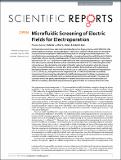| dc.contributor.author | Ge, Zhifei | |
| dc.contributor.author | Moran, Jeffrey L. | |
| dc.contributor.author | Buie, Cullen R. | |
| dc.contributor.author | Garcia, Paulo | |
| dc.date.accessioned | 2016-03-03T16:59:33Z | |
| dc.date.available | 2016-03-03T16:59:33Z | |
| dc.date.issued | 2016-02 | |
| dc.date.submitted | 2015-08 | |
| dc.identifier.issn | 2045-2322 | |
| dc.identifier.uri | http://hdl.handle.net/1721.1/101434 | |
| dc.description.abstract | Electroporation is commonly used to deliver molecules such as drugs, proteins, and/or DNA into cells, but the mechanism remains poorly understood. In this work a rapid microfluidic assay was developed to determine the critical electric field threshold required for inducing bacterial electroporation. The microfluidic device was designed to have a bilaterally converging channel to amplify the electric field to magnitudes sufficient to induce electroporation. The bacterial cells are introduced into the channel in the presence of SYTOX[superscript ®], which fluorescently labels cells with compromised membranes. Upon delivery of an electric pulse, the cells fluoresce due to transmembrane influx of SYTOX[superscript ®] after disruption of the cell membranes. We calculate the critical electric field by capturing the location within the channel of the increase in fluorescence intensity after electroporation. Bacterial strains with industrial and therapeutic relevance such as Escherichia coli BL21 (3.65 ± 0.09 kV/cm), Corynebacterium glutamicum (5.20 ± 0.20 kV/cm), and Mycobacterium smegmatis (5.56 ± 0.08 kV/cm) have been successfully characterized. Determining the critical electric field for electroporation facilitates the development of electroporation protocols that minimize Joule heating and maximize cell viability. This assay will ultimately enable the genetic transformation of bacteria and archaea considered intractable and difficult-to-transfect, while facilitating fundamental genetic studies on numerous diverse microbes. | en_US |
| dc.description.sponsorship | United States. Defense Advanced Research Projects Agency (Grant D13AP00025) | en_US |
| dc.language.iso | en_US | |
| dc.publisher | Nature Publishing Group | en_US |
| dc.relation.isversionof | http://dx.doi.org/10.1038/srep21238 | en_US |
| dc.rights | Creative Commons Attribution | en_US |
| dc.rights.uri | http://creativecommons.org/licenses/by/4.0/ | en_US |
| dc.source | Nature | en_US |
| dc.title | Microfluidic Screening of Electric Fields for Electroporation | en_US |
| dc.type | Article | en_US |
| dc.identifier.citation | Garcia, Paulo A., Zhifei Ge, Jeffrey L. Moran, and Cullen R. Buie. “Microfluidic Screening of Electric Fields for Electroporation.” Scientific Reports 6 (February 19, 2016): 21238. | en_US |
| dc.contributor.department | Massachusetts Institute of Technology. Department of Mechanical Engineering | en_US |
| dc.contributor.mitauthor | Garcia, Paulo | en_US |
| dc.contributor.mitauthor | Ge, Zhifei | en_US |
| dc.contributor.mitauthor | Moran, Jeffrey L. | en_US |
| dc.contributor.mitauthor | Buie, Cullen R. | en_US |
| dc.relation.journal | Scientific Reports | en_US |
| dc.eprint.version | Final published version | en_US |
| dc.type.uri | http://purl.org/eprint/type/JournalArticle | en_US |
| eprint.status | http://purl.org/eprint/status/PeerReviewed | en_US |
| dspace.orderedauthors | Garcia, Paulo A.; Ge, Zhifei; Moran, Jeffrey L.; Buie, Cullen R. | en_US |
| dc.identifier.orcid | https://orcid.org/0000-0003-1677-4572 | |
| dc.identifier.orcid | https://orcid.org/0000-0002-2275-4570 | |
| dc.identifier.orcid | https://orcid.org/0000-0002-0464-0385 | |
| dc.identifier.orcid | https://orcid.org/0000-0002-2593-055X | |
| mit.license | PUBLISHER_CC | en_US |
| mit.metadata.status | Complete | |
